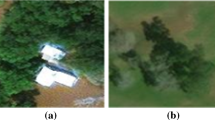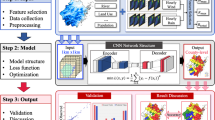Abstract
Damage assessment is one of the most important factors in estimating loss after hurricane. The assessment's findings are very important to identify casualties, temporary housing requirements, financial losses, socio-economic effects, etc. In this paper, our goal is to detect the damage using satellite images captured for the natural disasters like hurricane Harvey. In order to assist the experts to speed up the investigation process for providing the best recommendations this research study presents a compact deep learning-based automatic model to assess hurricane damage using satellite images. TRS-Net (Tropical Revolving Storm Network), model uses flood satellite images to identify the damage caused by the hurricane Harvey. The proposed model effectively extracted features from the satellite images by using depth-wise convolution with varying dilation rates. 23,000 satellite Harvey hurricane images of which 15,000 were damage images caused directly or indirectly and the remaining were the images of normal regions. The model included four clustered layers with convolution and max pooling layer enhanced with batch normalization and dropout to attain better accuracy in detecting the damage caused by hurricane Harvey. The dataset was trained and tested with three different optimizers like Adam, RMSProp and SGD where Adam outperformed the others with 98.57% of testing accuracy. Furthermore, based on the loss and accuracy curve, the performance evaluation of the dataset is analyzed. The experimental findings demonstrate that the suggested TRS-Net model achieves the greatest classification accuracy with 0.99, 0.98, 1.0, 0.96 as F1 Score, precision, sensitivity and specificity respectively. Therefore, the present work assist experts’ in efficient hurricane damage assessment and overcome the resource and time intensive manual assessment method.





Similar content being viewed by others
Data availability
None
Code availability
Programming codes available upon reasonable request.
References
Berezina P, Liu D (2022) Hurricane damage assessment using coupled convolutional neural networks: a case study of hurricane Michael. Geomat Nat Haz Risk 13(1):414–431
Elliott JR, Marcello de Michele and HK, Gupta (2020) "Earth observation for crustal tectonics and earthquake hazards. Surveys in Geophysics 41 1355–1389
Chen Sean Andrew, et al (2018) "Benchmark dataset for automatic damaged building detection from post-hurricane remotely sensed imagery." arXiv preprint arXiv:1812.05581
Sebastian Toni et al (2017) "Hurricane Harvey Report: A fact-finding effort in the direct aftermath of Hurricane Harvey in the Greater Houston Region."
Cao Quoc Dung, and Youngjun Choe (2018) "Detecting damaged buildings on post-hurricane satellite imagery based on customized convolutional neural networks." IEEE Dataport
Nwankpa Chigozie et al (2018)"Activation functions: Comparison of trends in practice and research for deep learning." arXiv preprint arXiv:1811.03378
Sharma S, Sharma S, Athaiya A (2017) Activation functions in neural networks. Towards Data Sci 6(12):310–316
Kumar Naresh, and Dhruv Aggarwal (2021) "LEARNING-based focused WEB crawler." IETE J. Res.: 1–9
Kumar Naresh et al (2021)"Efficient automated disease diagnosis using machine learning models." J. Healthc. Eng. 2021
Hossin Mohammad, and Md Nasir Sulaiman (2015) "A review on evaluation metrics for data classification evaluations." Int. j. data min. knowl. manag. proces 5.2: 1
Sherstinsky A (2020) Fundamentals of recurrent neural network (RNN) and long short-term memory (LSTM) network. Physica D 404:132306
Liang, Jiazhi (2020) "Image classification based on RESNET." Journal of Physics: Conference Series. Vol. 1634. No. 1. IOP Publishing
Vahid Rashidian et al (2021) Detecting Demolished Buildings after a Natural Hazard Using High Resolution RGB Satellite Imagery and Modified U-Net Convolutional Neural Networks. Remote Sens. 13(11):2176
Alom Md Zahangir, et al (2018) "The history began from alexnet: A comprehensive survey on deep learning approaches." arXiv preprint arXiv:1803.01164
Noever David et al (2020) "Discoverability in satellite imagery: A good sentence is worth a thousand pictures." arXiv preprint arXiv:2001.05839
Kuzin Danil et al (2021) "Disaster mapping from satellites: damage detection with crowdsourced point labels." arXiv preprint arXiv:2111.03693
Lam Darius et al (2018) "xview: Objects in context in overhead imagery." arXiv preprint arXiv:1802.07856
Jaffe L, Zelinski M, Sakla W (2019) Remote sensor design for visual recognition with convolutional neural networks. IEEE Trans Geosci Remote Sens 57(11):9090–9108
Hasanlou Mahdi et al (2021) Earthquake damage region detection by multitemporal coherence map analysis of radar and multispectral imagery. Remote Sens. 13(6):1195
Cooner AJ, Shao Y, Campbell JB (2016) Detection of urban damage using remote sensing and machine learning algorithms: Revisiting the 2010 Haiti earthquake. Remote Sensing 8(10):868
Kaur Swapandeep et al (2022) Transfer Learning-Based Automatic Hurricane Damage Detection Using Satellite Images. Electronics 11(9):1448
Ye Shi et al (2014) "Automated detection of damaged areas after hurricane sandy using aerial color images." Computing in Civil and Building Engineering 2014 1796–1803
Pi Y, Nath ND, Behzadan AH (2020) Convolutional neural networks for object detection in aerial imagery for disaster response and recovery. Adv Eng Inform 43:101009
Dawood Muhammad, Amina Asif, and Fayyaz ul Amir Afsar Minhas (2020) "Deep-PHURIE: deep learning based hurricane intensity estimation from infrared satellite imagery." Neural. Comput. Appl. 32: 9009–9017
Dotel Saramsha et al (2020) "Disaster assessment from satellite imagery by analysing topographical features using deep learning." Proceedings of the 2020 2nd International Conference on Image, Video and Signal Processing
Cheng C-S, Behzadan AH, Noshadravan A (2021) Deep learning for post-hurricane aerial damage assessment of buildings. Comput-Aided Civ Inf 36(6):695–710
Zbontar J, LeCun Y (2016) Stereo matching by training a convolutional neural network to compare image patches. J Mach Learn Res 17(1):2287–2318
Das N. Narayan et al (2022) Automated deep transfer learning-based approach for detection of COVID-19 infection in chest X-rays. Irbm 43(2):114–119
Naresh Kumar et al (2022) Automatic Diagnosis of Covid-19 Related Pneumonia from CXR and CT-Scan Images. Eng. Tech Appl. Sci. Res. 12(1):7993–7997
Karan Aggarwal et al (2022) Has the future started? The current growth of artificial intelligence, machine learning, and deep learning. Iraqi J Math Comput Sci 3(1):115–123
Pandey Neha, and S Natarajan (2016) "How social media can contribute during disaster events? Case study of Chennai floods 2015." 2016 International Conference on Advances in Computing, Communications and Informatics (ICACCI). IEEE
Lamovec Peter et al (2013) Detecting flooded areas with machine learning techniques: case study of the Selška Sora river flash flood in September 2007. J. Appl. Remote Sens. 7(1):073564–073564
Bahrepour Majid et al (2010) "Distributed event detection in wireless sensor networks for disaster management." 2010 international conference on intelligent networking and collaborative systems. IEEE
Nguyen Dat T et al (2017) "Damage assessment from social media imagery data during disasters." Proceedings of the 2017 IEEE/ACM international conference on advances in social networks analysis and mining 2017.
Robertson Brett W et al (2019) Using a combination of human insights and ‘deep learning’for real-time disaster communication. Progress in Disaster Science 2:100030
Acknowledgements
Malathy Jawahar acknowledges CSIR-CLRI for conducting this research work (A/2022/ LPT/MLP/1834).
Author information
Authors and Affiliations
Corresponding author
Ethics declarations
Conflict of interest
The authors declare that there are no conflicts of interest regarding the publication of this paper.
Additional information
Publisher's note
Springer Nature remains neutral with regard to jurisdictional claims in published maps and institutional affiliations.
Rights and permissions
Springer Nature or its licensor (e.g. a society or other partner) holds exclusive rights to this article under a publishing agreement with the author(s) or other rightsholder(s); author self-archiving of the accepted manuscript version of this article is solely governed by the terms of such publishing agreement and applicable law.
About this article
Cite this article
Jawahar, M., Jani Anbarasi, L., Jasmine S, G. et al. Trs-net tropical revolving storm disasters analysis and classification based on multispectral images using 2-d deep convolutional neural network. Multimed Tools Appl 82, 46651–46671 (2023). https://doi.org/10.1007/s11042-023-15450-6
Received:
Revised:
Accepted:
Published:
Issue Date:
DOI: https://doi.org/10.1007/s11042-023-15450-6




